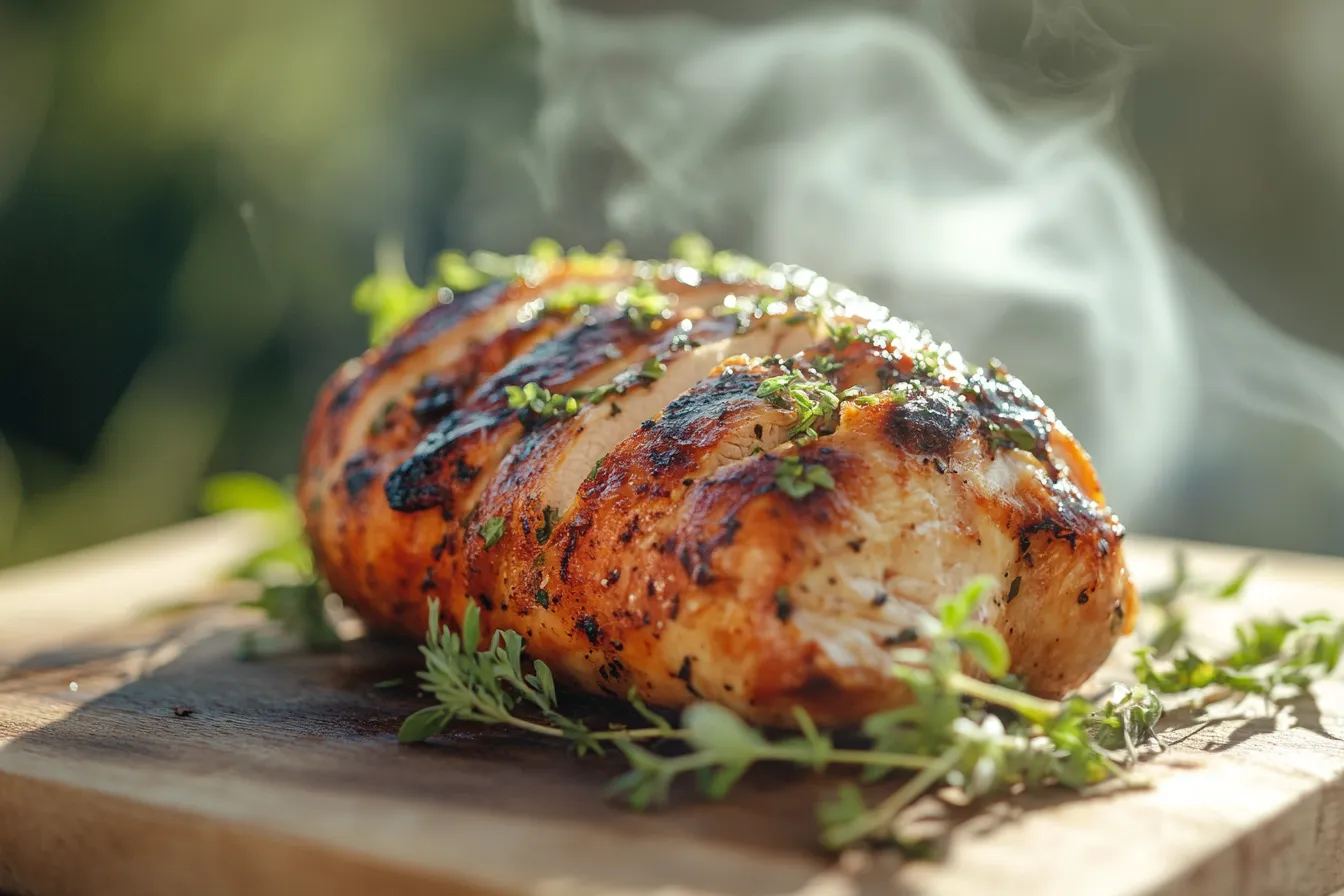Introduction
If you’ve ever bit into a piece of perfectly smoked chicken breast—tender, juicy, and infused with that irresistible smoky flavor—you know it’s a whole different game than just baking or grilling. Whether you’re new to using a smoker or looking to level up your BBQ skills, learning how to smoke chicken breast is a rewarding and delicious journey. With the right technique, anyone can master this art and impress family, friends, or guests at your next cookout..Blackstone Chicken Recipes
This guide will walk you through everything you need to know—from prepping your meat and choosing the right smoker to brining, seasoning, and nailing the smoking temperature. We’ll even cover common mistakes and how to serve your smoked chicken breast like a true pitmaster. Let’s fire it up!
Why Smoke Chicken Breast? Benefits & Flavor Profile
Smoking chicken breast isn’t just a trend—it’s a timeless technique that enhances flavor, texture, and overall appeal. Here’s why it’s become a favorite among backyard BBQ enthusiasts and professional chefs alike.
Healthier Alternative to Frying
Chicken breast is naturally lean and high in protein, making it a popular choice for health-conscious eaters. Smoking it allows you to enjoy rich, bold flavors without adding excess oil or fat, unlike frying. There’s no batter, no deep-frying—just clean, savory flavor enhanced by wood smoke and subtle spices.
Deep Smoke Flavor vs. Grilling or Oven Baking
While grilling or oven-roasting can produce delicious results, they simply can’t replicate the depth of flavor you get from smoking. The slow cooking process infuses the meat with layers of smokiness, transforming a plain chicken breast into something gourmet. Depending on the wood chips used (like applewood, hickory, or cherry), you can tweak the flavor to suit your taste..Blackstone Hibachi Chicken with Vegetables
Additionally, smoking keeps the meat moist and juicy by cooking it at low temperatures over a longer period. You avoid drying it out, which is a common issue with traditional cooking methods.
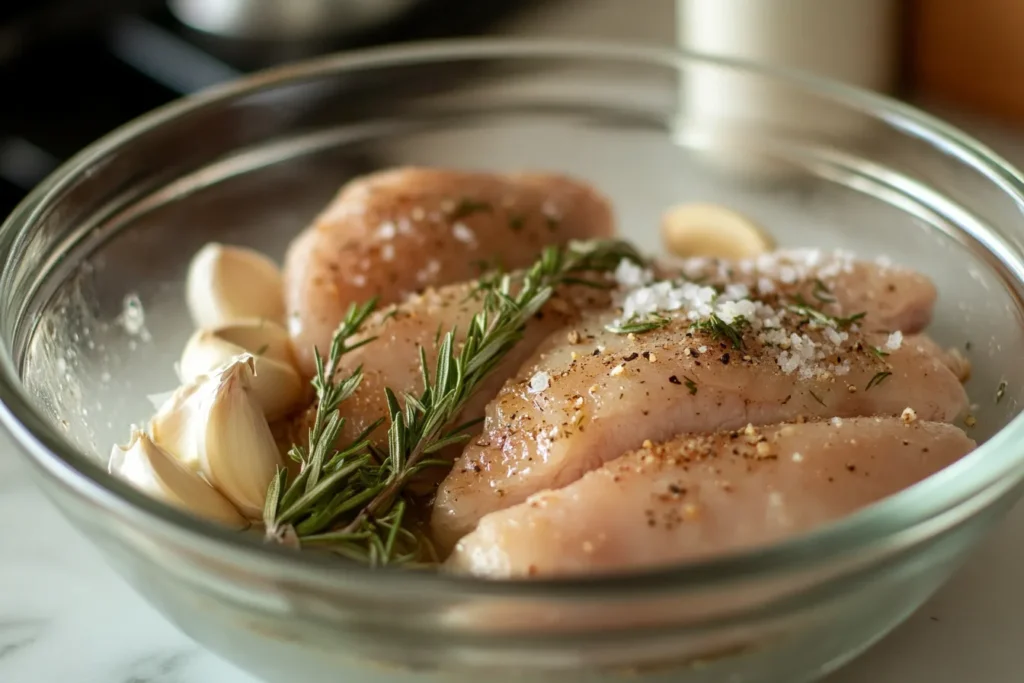
Preparing the Chicken
Proper preparation is key to successful smoking. Taking a few extra steps before your chicken hits the smoker will elevate the final result dramatically.
Choosing the Right Cut
Always start with high-quality, skinless, boneless chicken breasts. While bone-in versions are great for roasting, boneless breasts are easier to smoke evenly and absorb flavor more quickly. Look for organic or free-range poultry if possible, as it often has better texture and taste.
Brining: Why It’s Critical for Juicy Chicken
Brining is the secret weapon to ensure your smoked chicken breast turns out juicy and tender every single time. It works by soaking the meat in a saltwater solution that penetrates the fibers and helps the breast retain moisture during the long cooking process.
Simple Brine Recipe
Here’s a quick and effective brine you can use:
- 1/4 cup kosher salt
- 1/4 cup brown sugar
- 1 tbsp black peppercorns
- 2 crushed garlic cloves
- 4 cups water
Mix everything together until dissolved. Submerge your chicken breasts in the brine and refrigerate for 2–4 hours (no more than 6 hours or it may get too salty).
Dry Rub vs. Wet Marinade
After brining, rinse and pat the chicken dry. Now it’s time to season it. A dry rub made of paprika, garlic powder, onion powder, black pepper, and a little cayenne gives great flavor and a beautiful crust. Alternatively, a wet marinade with olive oil, lemon juice, and herbs can add brightness, but make sure it’s not too wet when smoking to prevent steaming instead of smoking..Delicious Dinner Ideas

Setting Up Your Smoker
Whether you’re using a pellet grill, offset smoker, electric smoker, or even a basic charcoal setup, preparing your smoker properly is crucial to achieving perfectly smoked chicken breasts. The setup affects not just the flavor but the cooking time and consistency.
Types of Smokers (Charcoal, Pellet, Electric)
Understanding your smoker helps you control flavor and temperature better:
- Charcoal Smoker: Delivers the richest, most authentic BBQ flavor. Use lump charcoal with a few wood chunks (apple, hickory, or cherry). It requires more manual control but gives impressive results.
- Pellet Grill: This is the go-to for convenience and precision. Just set the temperature and forget it. Great for beginners or multitaskers.
- Electric Smoker: Easy to use with digital control. While it doesn’t give quite the same deep smoke flavor as charcoal or pellets, it’s reliable and consistent.
- Gas Propane Smoker: Faster to heat and easier to manage, but often produces a milder smoke flavor unless enhanced with extra wood chips.
No matter the smoker type, the golden rule is low and slow cooking.
Ideal Temperature & Wood Selection
- Smoking Temperature: Preheat your smoker to a steady 225°F (107°C). This is the ideal low-and-slow range that allows chicken to cook gently, stay juicy, and soak up smoke flavor.
- Target Internal Temperature: The chicken is fully cooked and safe at 165°F (74°C), but you can pull it off the smoker at 160°F (71°C) and let carryover cooking finish the job.
- Best Woods for Chicken: Milder woods complement poultry. Top choices include:
- Applewood: Slightly sweet and fruity.
- Cherry: Rich in color and flavor, slightly sweet.
- Hickory: Stronger flavor, use lightly.
- Maple: Subtle and smooth, pairs well with spice rubs.
Avoid mesquite or other strong woods as they can overpower the delicate nature of chicken breast.
Smoking Process Explained
Now it’s time for the main event—smoking the chicken breast. Here’s how to do it right.
Preheat and Stabilize
Before placing the chicken inside, ensure your smoker has been preheated to 225°F for at least 20–30 minutes. Use a thermometer to verify the internal temperature stays consistent, as temperature swings can cause uneven cooking.
Add your soaked wood chips (if using a charcoal or electric smoker) or set your pellet blend if using a pellet smoker. Place a water pan in the smoker to maintain moisture and regulate heat.
Monitoring Internal Temperature
Once the chicken is in the smoker, insert a meat probe into the thickest part of the breast. Monitor the internal temperature closely. Avoid opening the smoker lid frequently—it lets heat and smoke escape, extending your cook time.
Expect cook time to range between 60 to 90 minutes, depending on the thickness of the breast and how steady your smoker temperature stays.
When to Wrap or Mop
While optional, you can lightly spritz your chicken breast every 30 minutes using a simple mix of apple cider vinegar and water to keep the surface moist and improve bark formation.
If you notice the exterior darkening too fast, wrap the chicken in foil at 150°F (65°C) and finish cooking it wrapped until it hits the target internal temp.
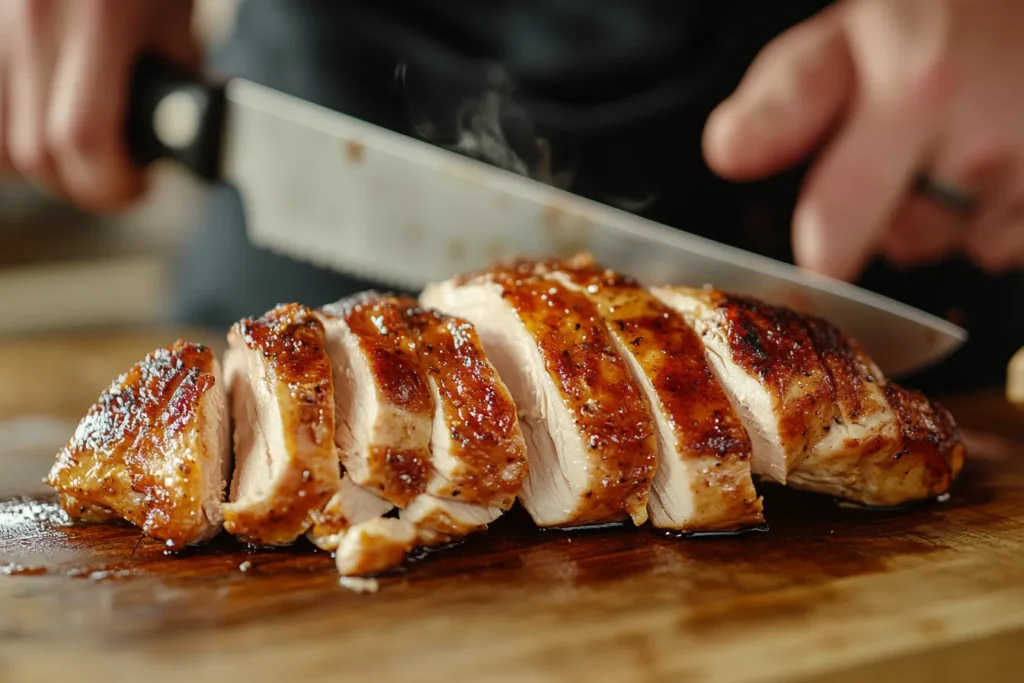
Resting and Slicing
You’ve smoked your chicken to perfection—but wait! Don’t cut into it just yet. Resting is a crucial final step to lock in juices and enhance flavor.
Carryover Cooking & Safe Minimum Temperature
Once your chicken breast reaches an internal temperature of 160°F (71°C), remove it from the smoker and tent it loosely with foil. During this time, carryover cooking continues, bringing the internal temp up to the safe USDA-recommended 165°F (74°C). This 5-minute rest also allows the juices to redistribute throughout the meat instead of spilling out onto your cutting board.
Skipping this step can leave you with dry chicken, even if the cooking process was perfect.
How to Slice for Maximum Juiciness
Always slice your chicken against the grain—this shortens the muscle fibers and results in more tender bites. Use a sharp carving knife and slice at a slight angle for presentation-ready pieces.
For serving in sandwiches, tacos, or salads, thinner slices or shreds are best. For plating as a main protein, cut into thicker slices.
Serving Suggestions & Pairings
Smoked chicken breast is incredibly versatile and can be served hot, cold, or even repurposed for meals throughout the week.
Side Dishes That Complement Smoked Chicken
Here are some perfect pairings that enhance the smoky flavor without overpowering it:
- Smoked Mac and Cheese – A creamy, cheesy side that balances out the savory chicken.
- Grilled Corn on the Cob – Adds sweetness and a bit of char.
- Garlic Mashed Potatoes – A comfort food classic.
- Coleslaw with Vinegar Dressing – Cuts through the richness with some tang.
- Grilled Asparagus or Zucchini – For a lighter, low-carb option.
Using Your Leftovers
Smoked chicken breast stores well and actually improves in flavor as it rests. You can refrigerate leftovers for up to 4 days or freeze for up to 2 months.
Here are some delicious leftover ideas:
- Smoked Chicken Salad – Mix chopped chicken with Greek yogurt, celery, mustard, and herbs.
- BBQ Chicken Tacos – Add slaw and a dash of hot sauce.
- Smoked Chicken Alfredo – Toss into creamy pasta for a smoky twist.
- Pizza Topping – Add to homemade or store-bought pizzas with BBQ sauce and red onion.
- Wraps or Sandwiches – Cold or hot, smoked chicken works with any bread or tortilla.
You can also dice and freeze portions in airtight bags for quick weeknight meals.
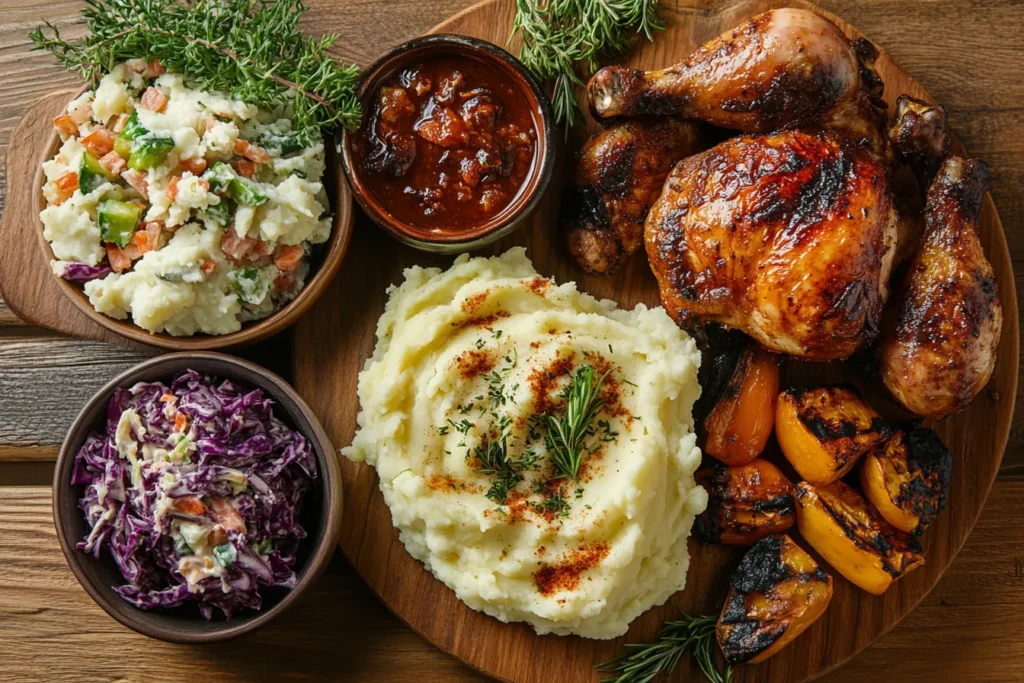
Common Pitfalls & Troubleshooting
Even with the right smoker and good intentions, it’s easy to make a few mistakes along the way. Fortunately, they’re all avoidable once you know what to look out for.
Dry, Overcooked Chicken
This is the number one complaint from first-time smokers. Chicken breast is lean and can dry out quickly if:
- It’s overcooked past 165°F.
- The smoker temperature is too high.
- It wasn’t brined beforehand.
Fix: Always brine your meat and use a reliable meat thermometer. Pull the chicken off the smoker at 160°F and let it rest under foil for 5–10 minutes to finish cooking via carryover heat.
Uneven Smoke Rings or Flavor
If your chicken breast ends up with patchy color or dull taste, it may be due to inconsistent heat or airflow in the smoker.
Fix: Use a water pan and avoid opening the lid frequently. Place the meat where the heat and smoke flow most evenly. Clean your smoker before each use to prevent old grease and ash from tainting the flavor.
Tips to Enhance Smoke Flavor
Want to add even more BBQ magic to your smoked chicken? Try these expert tips for bolder, deeper flavor.
Adding Moisture: Mops & Spritzers
Using a mop sauce or spritzer adds flavor and keeps the exterior moist during the smoke session. Try this easy apple cider vinegar spritz:
- 1 cup apple cider vinegar
- 1/4 cup apple juice
- 1 tbsp Worcestershire sauce
- Optional: dash of hot sauce or garlic powder
Spray every 30–45 minutes starting after the first 45 minutes of cooking. Be careful not to soak the meat, just a light mist.
Wood Chip Combinations
Blending woods gives you a chance to get creative with your smoke profile. Try mixing:
- Apple + Cherry for a slightly sweet and fruity flavor.
- Hickory + Maple for a richer, smokier profile with balance.
- Pecan + Apple for a nutty, mellow finish.
Soak your wood chips for 30 minutes before use to create more smoke and slow down the burn.
Pro Tip: Avoid adding too many chips at once. A light, thin blue smoke is ideal—thick white smoke can taste bitter and overpower your meat.
Health & Safety Considerations
When dealing with poultry, food safety is just as important as flavor. Here’s how to keep your smoked chicken breast delicious and safe.
Food Safety When Smoking Chicken
- Internal Temperature: Chicken is only safe to eat when it reaches an internal temperature of 165°F (74°C). Always use a digital thermometer and test the thickest part of the breast.
- Avoid Cross-Contamination: Clean your prep surfaces and utensils after handling raw chicken. Use separate cutting boards for raw and cooked meat.
- Safe Marinade Practices: Never reuse a marinade or brine that’s had raw chicken in it unless it’s been boiled first.
Storing and Reheating Leftovers
- Refrigeration: Place leftover smoked chicken breast in an airtight container and refrigerate within 2 hours of cooking. It will last for 3–4 days in the fridge.
- Freezing: To keep it longer, freeze in freezer-safe bags with as little air as possible. Use within 2 months for the best quality.
- Reheating: Gently reheat in a 275°F oven wrapped in foil to prevent drying out. Add a splash of broth or water before sealing the foil to restore moisture.
FAQ
Can you smoke boneless vs bone-in chicken breast?
Yes! Boneless breasts smoke faster and are easier to slice, while bone-in options take longer but retain moisture better. Both work well—just adjust your cooking time accordingly.
How long does smoked chicken breast last in the fridge?
Smoked chicken breast stays fresh for 3 to 4 days when stored properly in the refrigerator. For longer storage, freeze it for up to 2 months.
What is the best wood for smoking chicken breast?
Applewood and cherry are the best for a mild, sweet flavor. For something bolder, hickory works well in moderation. Avoid mesquite—it’s often too strong for chicken.
Can I smoke chicken breast without a smoker?
Yes! You can use a regular grill with a smoke box or foil pouch filled with wood chips. Maintain indirect heat at 225°F and close the lid tightly to simulate a smoker.
Should I butterfly the chicken breast before smoking?
You can! Butterflying evens out the thickness and helps the meat cook more evenly. Just be careful not to overcook the thinner ends.
What’s the ideal internal temperature for smoked chicken breast?
The USDA recommends 165°F (74°C) for safety, but you can pull it off at 160°F and let it rest under foil. The temperature will rise as it rests.
Conclusion
Smoking chicken breast is one of the simplest and most rewarding BBQ techniques you can master. With just a few ingredients and the right method, you can transform an ordinary chicken breast into a smoky, juicy, flavor-packed meal that everyone will love.
From prepping with a proper brine and seasoning rub to maintaining your smoker at the right temperature, every step matters. The beauty of smoking is that it’s as much about the journey as it is about the destination—and with practice, you’ll keep discovering new flavor profiles, wood combinations, and creative ways to serve your smoked chicken.
So next time you’re firing up the smoker, skip the guesswork and follow these tried-and-true tips. You’ll get perfectly smoked chicken breasts every time—and impress your guests like a true pitmaster.
USDA Poultry Safety Guidelines – https://www.fsis.usda.gov/food-safety/safe-food-handling-and-preparation/poultry
Anchor Text: safe poultry cooking practices
ThermoWorks Cooking Temperature Guide – https://www.thermoworks.com/food-temperature-chart/
Anchor Text: chicken internal temperature chart
Kingsford: Guide to Smoking Woods – https://www.kingsford.com/grill-guide/bbq-smoking-wood-chart/
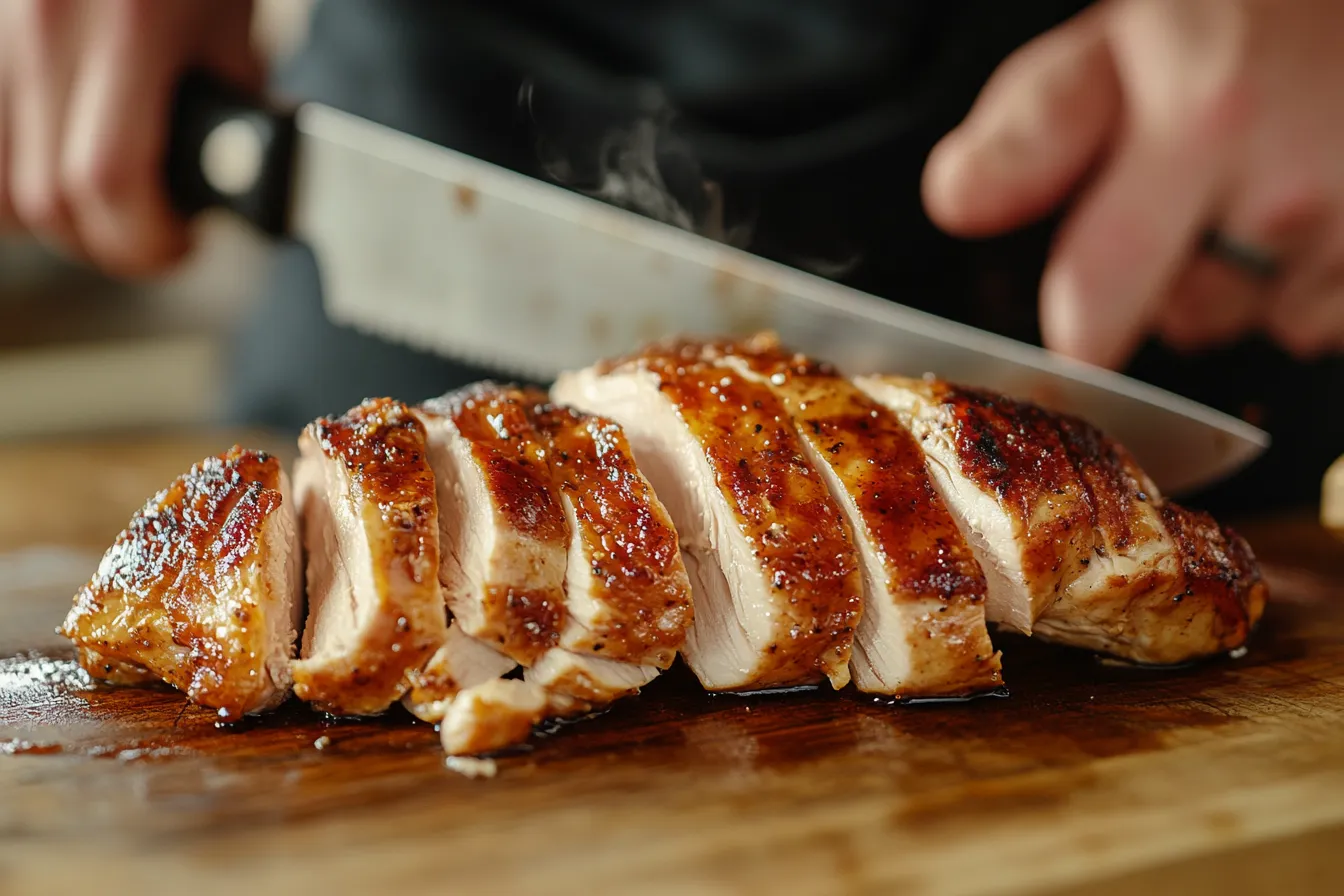
Name: Smoked Chicken Breast
Ingredients
Equipment
Method
- Instructions:
- Brine the Chicken (Optional but recommended):
- In a large bowl, dissolve salt and sugar in water. Add garlic and peppercorns. Submerge chicken breasts in brine. Cover and refrigerate for 2 to 4 hours.
- Preheat Smoker:
- Preheat your smoker to 225°F (107°C). Choose mild wood chips like applewood, cherry, or maple.
- Season Chicken:
- Remove chicken from the brine, rinse, and pat dry with paper towels. Apply your dry rub evenly on all sides.
- Place on Smoker:
- Put the chicken breasts directly on the smoker grates. Insert a thermometer into the thickest part.
- Smoke Until Done:
- Smoke for about 60–90 minutes, or until internal temperature reaches 160°F (71°C). Spritz every 30–45 minutes if desired.
- Rest the Chicken:
- Remove from the smoker and tent with foil. Let rest for 5–10 minutes to reach the safe internal temperature of 165°F (74°C).
- Slice and Serve:
- Slice against the grain and serve hot, or chill for meal prep or leftovers.
Notes
Don’t over-brine — more than 6 hours can make the chicken too salty. Always monitor temperature with a reliable meat probe, not just time. Add wood chips in small amounts to avoid bitter, heavy smoke. Pairs great with grilled veggies, coleslaw, or BBQ beans.

